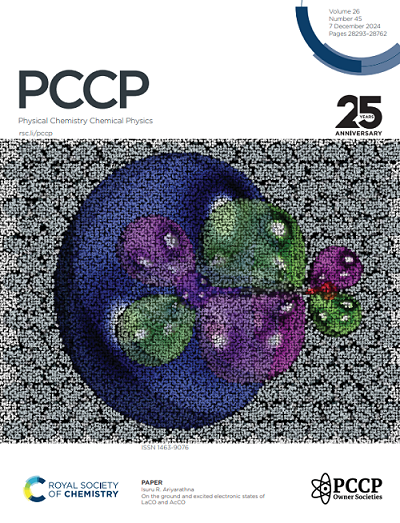正丙胺的UV-VUV吸收光谱及光解动力学
IF 2.9
3区 化学
Q3 CHEMISTRY, PHYSICAL
引用次数: 0
摘要
本文首次报道了同步辐射下正丙胺在4万~ 75000 cm-1 (5.0 ~ 9.3 eV)波段的紫外-紫外吸收光谱。在基于TDDFT的计算的帮助下进行了详细的光谱分析。发现正丙胺的电子激发态均为Rydberg,利用量子缺陷分析将Rydberg级数收敛到正丙胺的第一IP上。对五种稳定构象的垂直激发态进行了理论模拟,较准确地再现了室温吸收光谱的强度分布。与3s、3p和4s跃迁相关的振动结构清楚地显示出NH2摆动模式的主导激发,这意味着NH2基团从基态的金字塔结构转变为激发态的平面结构。此外,利用frank - condon因子对3s Rydberg中振动带的相对强度进行了模拟,结果与实验结果基本吻合。利用DFT方法进行二面角松弛势能扫描,发现阳离子基态有两个稳定的构象,而中性基态有五个稳定的构象,这可能对天体物理研究具有重要意义。利用大气模拟中一个有价值的输入——紫外区的吸收截面数据,模拟了正丙胺的光解速率和寿命随地面高度的变化。此外,详细的激发态势能扫描,包括约束和放松,沿着每个可能的键裂解通道,揭示了分子光解动力学的新见解。本文章由计算机程序翻译,如有差异,请以英文原文为准。
UV-VUV absorption spectroscopy and photodissociation dynamics of n-propylamine
We report for the first time, the UV-VUV absorption spectrum of n-propylamine in the wavenumber range 40,000 to 75,000 cm-1 (5.0–9.3 eV) using synchrotron radiation. A detailed spectral analysis is performed with the help of TDDFT based calculations. All the electronic excited states of n-propylamine are found to be Rydberg in nature, quantum defect analysis is used to assign Rydberg series converging to the first IP of n-propylamine. Theoretical simulation of the electronic absorption spectrum is done including vertical excited states of all five stable conformers which reproduces quite accurately, the observed intensity profile of the room temperature absorption spectrum. Vibrational structure associated with the 3s, 3p and 4s transitions clearly shows a dominant excitation of the NH2 wagging mode implying a transformation of the NH2 group from pyramidal structure in the ground state to planar in the excited state. Further, relative intensities of vibronic bands in the 3s Rydberg are simulated using Franck-Condon factor calculations and show overall good agreement with experiment. Relaxed potential energy scans across dihedral angles using DFT method reveal two stable conformers in the cationic ground state in contrast to five in the neutral ground state, which may have important implications in astrophysical studies. Absorption cross section data in the UV region, a valuable input in atmospheric modelling is used to simulate the variation of photolysis rate and lifetime of n-propylamine with terrestrial altitude. Additionally, detailed potential energy scans of excited states, both constrained and relaxed, along each of the possible bond cleavage channels are presented, revealing new insights into the photodissociation dynamics of the molecule.
求助全文
通过发布文献求助,成功后即可免费获取论文全文。
去求助
来源期刊

Physical Chemistry Chemical Physics
化学-物理:原子、分子和化学物理
CiteScore
5.50
自引率
9.10%
发文量
2675
审稿时长
2.0 months
期刊介绍:
Physical Chemistry Chemical Physics (PCCP) is an international journal co-owned by 19 physical chemistry and physics societies from around the world. This journal publishes original, cutting-edge research in physical chemistry, chemical physics and biophysical chemistry. To be suitable for publication in PCCP, articles must include significant innovation and/or insight into physical chemistry; this is the most important criterion that reviewers and Editors will judge against when evaluating submissions.
The journal has a broad scope and welcomes contributions spanning experiment, theory, computation and data science. Topical coverage includes spectroscopy, dynamics, kinetics, statistical mechanics, thermodynamics, electrochemistry, catalysis, surface science, quantum mechanics, quantum computing and machine learning. Interdisciplinary research areas such as polymers and soft matter, materials, nanoscience, energy, surfaces/interfaces, and biophysical chemistry are welcomed if they demonstrate significant innovation and/or insight into physical chemistry. Joined experimental/theoretical studies are particularly appreciated when complementary and based on up-to-date approaches.
 求助内容:
求助内容: 应助结果提醒方式:
应助结果提醒方式:


